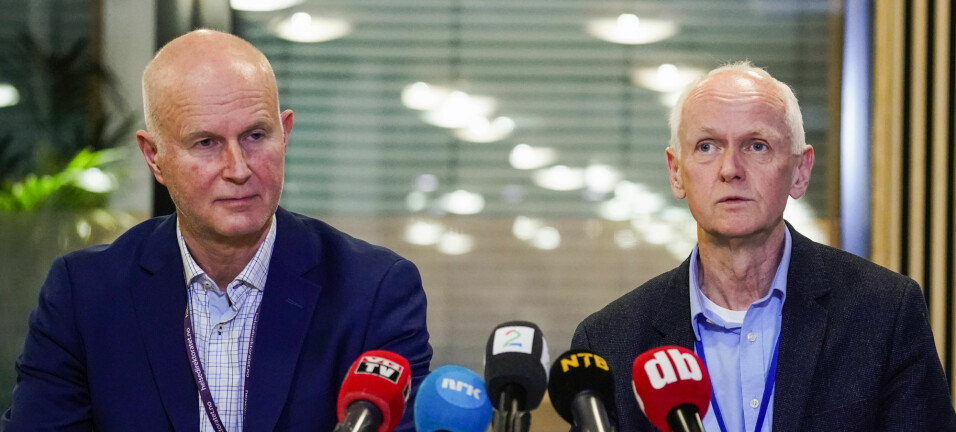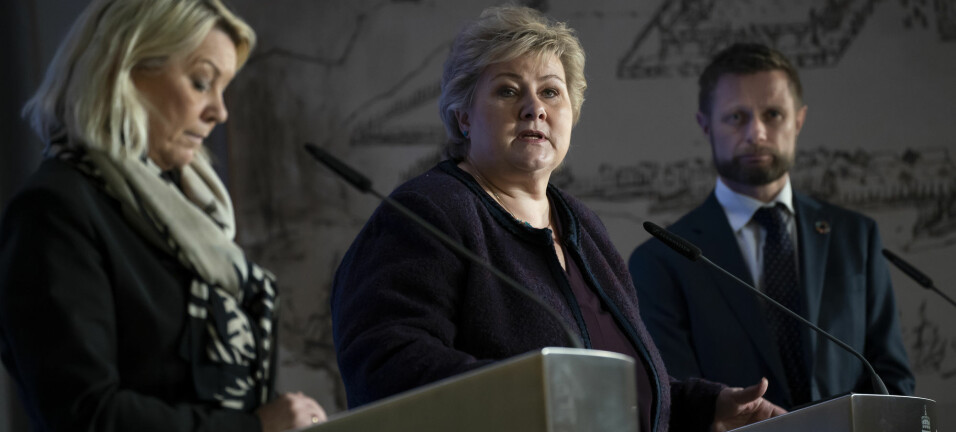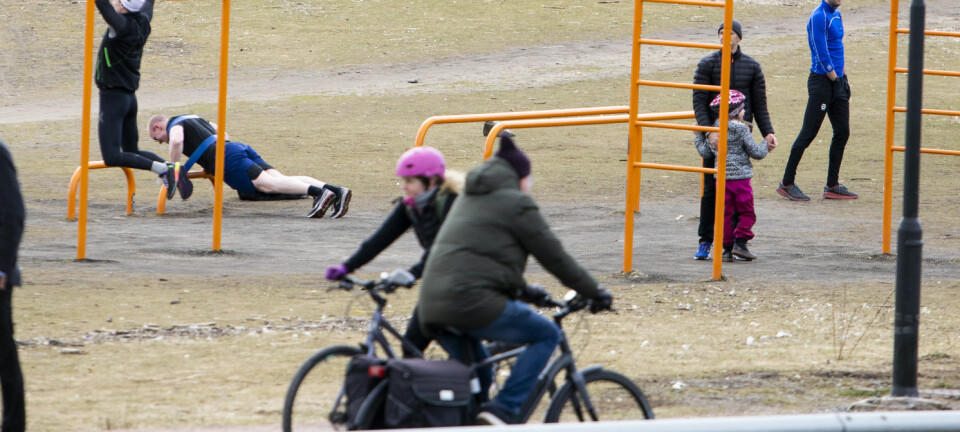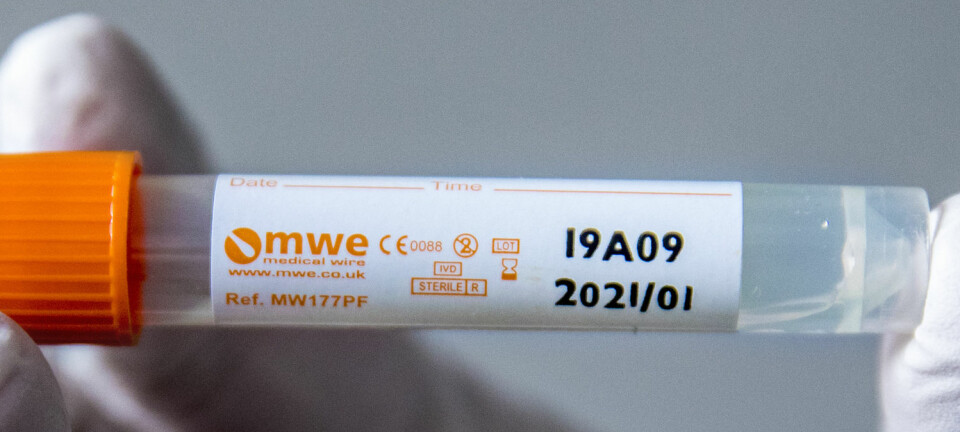Share your science:
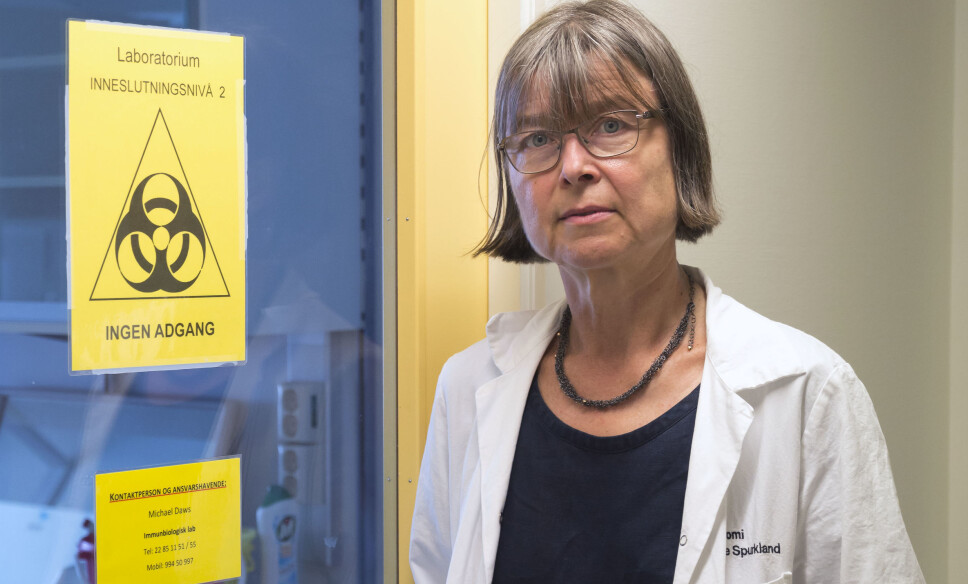
Professor and immunologist: I don't want COVID-19
SHARE YOUR SCIENCE: Anne Spurkland, professor of moleculary immunology, has devoured available research on COVID-19. What she's found, has made her worried: “Give me a vaccine against this virus as soon as possible. “
This article was first published in Norwegian at Harvestmagazine.no.
1. Diary from the time of corona
It has been four weeks since Norway closed down and kindergarten children, pupils, university students, teachers and more or less “everyone” were told to stay home. Since then, I have only been on short walks in my neighbourhood. No grocery shopping, no public transportation, no close contact with anyone but my immediate family.
We’re healthy. The little cold from before lockdown is gone. My enthusiasm for matauk – home gardening and foraging to increase the supply of food – and my general unwillingness to throw away food has come in handy now. We have enough calories stored to carry us safely through several months of isolation. We make use of everything we have and compete with ourselves to see how long we can make everything stretch without going to the grocery store.
I hear from people I know that their family has been suffering from COVID-19 for almost three weeks. The kids are doing fine. One of the adults is still knocked out with a fever and has lost their sense of smell. The other adult’s fever and back pain from the first few days have returned after feeling better for a few days. And it turns out to be remarkably difficult for them to get enough air.
In the daily newspaper VG, 30 people have shared their experiences from being infected: One reports dizziness and headaches, another describes stabbing chest pain and laboured breathing. One says that it’s fascinating to observe how their health fluctuates: After one week you think you’re recovered, and then it gets worse again.
2. The world as a laboratory
COVID-19 is a completely new illness for everyone. Not a single person in the world has had this disease before – until the first cases appeared in China a little over three months ago. From the moment the pandemic was a fact, the whole world has become an experimental laboratory in which we are all taking part.
Each new patient can provide us with new insights. How many are infected? How many become ill? What do the people who become ill have in common? What are the symptoms? What is the treatment? How long does the illness last?
In the first three months of the year, 1924 scientific papers on COVID-19 were published. All major medical journals have their own COVID-19 sections with articles, comments and the exchange of opinions. Researchers share their research results in open article archives before their work has been peer reviewed. Evidence-based research has been moved out into the open. Pieces of new information are highlighted in the media before they have been reviewed and tested by other scientists.
3. SARS and COVID-19
The new coronavirus which is causing us to stay at home has been named SARS-CoV-2. It is similar to the SARS-CoV virus that gave us SARS, the disease that affected several countries in Southeast Asia in 2003. That virus was not as contagious. It mainly spread to those who came in close contact with infected or sick people, and the epidemic was stopped by isolating the sick.
SARS mainly attacked the lungs. Patients developed severe acute respiratory syndrome (SARS) and many of the people who became infected died.
In recent years, I've been talking to many different audiences about the immune system so that people can better understand it. I have written blog posts and published a book using simple pictures and words to explain how the different parts of the immune system work.
Now, however, I am constantly receiving questions from readers and journalists which I am unable to answer as I am entering an unfamiliar professional terrain.
Why are the elderly more vulnerable to the disease? Why are men more at risk than women? What happens when the virus enters the body? Well, that is when the virus meets the immune system.
4. A one-minute overview of the immune system
The immune system is divided into two main parts: the innate and the adaptive immune system. The innate immune system is inherited directly from your parents, while the adaptive immune system is developed throughout the course of your life.
When a virus enters the body, the innate immune system is the first to step up. At the same time, a message is sent to immune cells in the adaptive immune system telling them to kick-start the production of antibodies and virus-specific killer cells.
It is the adaptive immune system that develops our immunity – and makes vaccines work. After an infection or vaccine, the adaptive immune system has been permanently altered, and will forever have the ability to respond should the same microbe reappear.
5. Wasgij – putting together pieces of an unknown puzzle
The demand for immunological insight these first few weeks of the pandemic has been overwhelming. I alternate between teaching students via Zoom and educating journalists over the phone. I spend my days checking statements I’ve given, having meetings with colleagues and doing quick searches on the research literature.
Any free time in the evenings is used to publish information on social media. That’s also a space where your daily life in quarantine is exposed. A former research fellow posts a picture of a Wasgij puzzle with 1000 pieces that they’ve embarked on. The final picture is hidden – the person putting together the pieces must extrapolate what the picture will look like from indirect hints. The puzzle was a gift from me for their doctorate, intended to serve as a metaphor for how researchers work.
The search for answers about COVID-19 is just like a puzzle with an unknown number of pieces. There are so many questions and – so far – so few answers. The picture we are working to put together is still unknown: we need to build on what we already know, add bits of new information and look for patterns. To this end, the comparison with SARS is useful.
Are the two diseases similar enough that survivors of SARS are protected against COVID-19?
6. An important piece of the puzzle for COVID-19
In early March, a German research group published a new piece of the COVID-19 puzzle (1). It turns out that the SARS and COVID-19 viruses closely resemble each other. The spike protein S, which protrudes from the surface of corona viruses and gives them their distinctive crown-like appearance, is almost identical between the two.
The virus uses the protein to attach to our cells. The recipient protein on our cells has also been identified: it is an enzyme with a name I’m already quite familiar with; Angiotensin Converting Enzyme 2 (ACE2). Angiotensin is a hormone that causes an increase in blood pressure. The role of ACE2 is to reduce this reaction in order to get the person’s blood pressure back down.
Both the SARS and COVID-19 virus use ACE2 to infect cells that have this enzyme on the surface. Antibodies from survivors of the SARS epidemic don’t only serve to block the SARS virus, but also the COVID-19 virus to some extent. When antibodies are bound to the virus, it prevents the virus from entering the cells. Without access to our cells, the virus cannot multiply.
This is good news, as it means our immune system will be able to combat this virus by producing antibodies – it is only a matter of time.
7. New questions, new symptoms
Researchers who examined patients who died of SARS discovered that the virus not only existed in the lungs, but also had spread to other parts of the body. They detected the virus in surface cells in the respiratory tract, lungs, kidneys and intestines (2). All of these cell types have ACE2 on the surface.
Even though it is the acute lung failure which is the most life-threatening, it is very interesting that the virus is also capable of infecting other cells beyond the lungs. Now that COVID-19 is among us, we’re hearing more stories about what it is like to be sick with this virus:
COVID-19 is not just a pneumonia. Some have few or no symptoms at all, some only have respiratory symptoms, while others have diarrhoea or lower back pain in the area where the kidneys are located. This fits in with the observation that COVID-19, like SARS, can affect several organs of the body – not just the lungs. But how does that happen?
If the virus enters the body through the airways, can it spread from there to the rest of the body through the bloodstream? That happens for some viruses. But there is also another possibility which we should investigate more closely.
8. A Trojan horse?
The research team that examined deceased SARS patients also detected the virus in immune cells (2). All white blood cells are immune cells. They are categorized into several different groups. Most immune cells belong to the innate immune system, while lymphocytes belong to the adaptive immune system.
Immune cells usually do not have ACE2 on the surface, yet the virus was found in many of the immune cells of patients who had died from SARS. SARS viral particles were not only found in cells from the innate immune system, but also in lymphocytes from the adaptive immune system.
Could the immune cells have transported the virus from the lungs to other areas of the body? Did the SARS virus exploit immune cells, using them as Trojan horses?
9. Nobody home
Even more disturbing was the discovery that patients who had died of SARS lacked lymphocytes in their lymph nodes, spleen and intestines. In the places in these organs where the cells from the innate and adaptive immune system meet, you would normally find plenty of immune cells. This is where lymphocytes get the information that a new virus has infected the body; and this is where the few lymphocytes that are able to respond will divide and multiply until there are enough to protect against the virus. Here, however, almost no lymphocytes were present.
It is possible that this happens in all patients dying from similar severe and stressful diseases, with lung and other organ failure, but the researchers nonetheless found this observation to be significant. A low number of lymphocytes in the tissue corresponds well with the fact that fewer such blood cells were also found in blood samples from patients at an early stage of the disease. A reduced number of lymphocytes is also common in patients with COVID-19.
One recurring question is: why is the course of the disease so variable? And how is it that some people hardly even notice that they have a COVID-19 infection, while others are severely ill for weeks?
10. Delayed signal
In the search for more puzzle pieces I came across Dr Stanley Perlman from Iowa. To me, Iowa evokes fond memories of skiing for several kilometres in 25 degrees below zero over the flat fields surrounding the university in Ames in my own anorak that I brought along and with a borrowed pair of skis.
Perlman works at the University of Iowa City. For 38 years, he has studied pneumonia caused by corona and influenza viruses. At the end of January this year, he concluded his comment on the discovery of the SARS-CoV-2 virus in the following way: “Public health measures, including quarantining in the community as well as timely diagnosis and strict adherence to universal precautions in health care settings, were critical in controlling SARS and MERS. Institution of similar measures will be important and, it is hoped, successful in reducing the transmission of 2019-nCoV” (3). Less than two months later, much of the Norwegian workforce started working from home. The global community responded too late.
Perlman is also one of the few researchers who maintained an interest in SARS even after 2003. Scientists have created animal models of the disease and studied it in research labs. SARS-CoV did not cause severe illness in any of the animals. However, the researchers in Iowa succeeded in altering the virus so that SARS-CoV could bind to the cells of mice. In a publication from 2016 (4) they describe how delayed signalling of the SARS infection made the mice much sicker. The virus has properties that short-circuit the cells’ own innate immune system during the first few hours of the infection.
This delayed signalling leads to severe lung disease in the mice.
11. Genes are essential
Mice are the favourite animal of immunologists. Through systematic inbreeding, generations of researchers have established different populations of mice that are genetically identical. In addition, it has been possible for many years to make mice that lack certain genes. Such mice are very useful for understanding how different parts of the immune system work.
Among other things, Perlman has shown that the genetic background of the mouse determines whether it will get sick from the SARS virus. Mice from one of the distinct mouse populations will hardly get sick at all, while mice from a different population will get sicker the older they are at the time of infection.
That’s exactly the same thing we’re seeing in the current pandemic: the elderly are the most severely affected, while younger people mostly walk away unscathed.
12. Dodging the cell’s protective measures
Like all viruses, coronaviruses are not truly alive; each virus is a small package of genetic material in the form of RNA and some proteins, and it needs to enter our cells to multiply. When one COVID-19 virus attaches to ACE2 on one of our cells, the cell is forced to release the virus into the cytoplasm – the fluid that fills a cell. The virus will then go on to exploit the cell’s own machinery to generate new virus particles. The new COVID-19 viruses are then released from the infected cell and can go on to infect nearby cells.
For the individual cell, a viral infection is a highly dramatic event. That is why all cells carry an innate immune system of their own that can recognise and respond to the threat. The presence of foreign genetic material, or if genetic material is present at the wrong place in a cell, is a red alert. Minutes after the cell’s defence molecules have detected danger, the cell starts to emit a hormone called interferon. Interferon signals to nearby cells that danger is afoot: “Brace yourselves, decrease all activity, create unusable dummy molecules to stop the virus”. Interferons also sends the immune cells of both the innate and adaptive immune system a clear message that they need to respond to the impending threat.
Interferons are highly effective and are essential to limit and stop a viral infection at an early stage. Mice infected with the influenza virus become severely ill if the interferon signal is missing. Many viruses that cause serious illness have found ways to evade the interferon system so that the infected cell doesn’t send any signals about the present danger, ensuring that the nearby cells are quite unprepared when the storm of virus particles hits them in the next round.
Just like with SARS-CoV, the SARS-CoV-2 virus has several different ways of preventing the infected cell from releasing interferons. The result is a delayed interferon signal.
13. Too much, too late
Perlman and his people discovered that the virus-infected mice became terminally ill by SARS due to the delay in the interferon signal (4), which caused the cells of the innate immune system to react too forcefully. For some reason, the delay meant that the adaptive immune system did not react as effectively as it should. In the chaos of signals that followed, the mice suffered acute respiratory failure, and most of them died.
When the same experiment was done on mice that lacked interferon receptors, the mice tolerated an infection with SARS-CoV quite well, and did not develop significant illness. Normal mice that received interferon a few hours before they were infected by the virus also did not develop any severe illness.
These were surprising results: the fact that the part of the innate immune system which usually enables us to withstand a viral infection was actually the triggering factor that caused the mice to become severely ill.
14. Three weeks in immune chaos
It has been four weeks since COVID-19 penetrated everyday life in Norway. This disease is completely new to us. Perlman and other experienced SARS researchers have only had a few weeks to survey what is happening. In our part of the world, the work to collect of samples and gather information about patients with COVID-19 is only just getting started. The puzzle pieces we currently have only provide us with a rather blurry and chaotic picture for now.
Nonetheless, I’ve made up my mind. I actually do not want to get COVID-19. I’ll wait until a vaccine is ready. I also don’t want any of my loved ones to get this disease.
I do not wish for a virus that delivers such a variable disease as COVID-19 to enter my body. I don't want to take the chance that my ordinarily efficient innate immune system might not be up to this task.
I don't want a disease where the virus not only attacks the respiratory tract, but possibly also my own immune cells. I don't want a virus that removes or disrupts the signals and cells that keep my immune system in balance.
I do not wish to be exposed to the whims of an immune system which is no longer carefully controlled, but has instead become unpredictable and volatile and might bring my body to the brink of collapse. I do not wish to become one of the patients who require breathing assistance to get through the immune chaos in their body.
I'm not afraid. I do not need to be reminded that the chance of a fatal outcome of the disease is low, even for women at my age. I also have no doubt that my adaptable immune system will eventually resume control of the situation and the virus so that I develop immunity.
But I still don't want to be part of the immunological experiment that COVID-19 presents. That’s not how I want to achieve herd immunity. I’d rather have someone give me a vaccine against this virus as soon as possible.
———
1. Hoffmann, M., H. Kleine-Weber, S. Schroeder, N. Kruger, T. Herrler, S. Erichsen, T. S. Schiergens, G. Herrler, N. H. Wu, A. Nitsche, M. A. Muller, C. Drosten, and S. Pohlmann. 2020. SARS-CoV-2 Cell Entry Depends on ACE2 and TMPRSS2 and Is Blocked by a Clinically Proven Protease Inhibitor. Cell.
2. Gu, J., E. Gong, B. Zhang, J. Zheng, Z. Gao, Y. Zhong, W. Zou, J. Zhan, S. Wang, Z. Xie, H. Zhuang, B. Wu, H. Zhong, H. Shao, W. Fang, D. Gao, F. Pei, X. Li, Z. He, D. Xu, X. Shi, V. M. Anderson, and A. S. Leong. 2005. Multiple organ infection and the pathogenesis of SARS. J Exp Med 202: 415-424.
3. Perlman, S. 2020. Another Decade, Another Coronavirus. The New England journal of medicine 382: 760-762.
4. Channappanavar, R., A. R. Fehr, R. Vijay, M. Mack, J. Zhao, D. K. Meyerholz, and S. Perlman. 2016. Dysregulated Type I Interferon and Inflammatory Monocyte-Macrophage Responses Cause Lethal Pneumonia in SARS-CoV-Infected Mice. Cell Host Microbe 19: 181-193.
Share your science or have an opinion in the Researchers' zone
The ScienceNorway Researchers' zone consists of opinions, blogs and popular science pieces written by researchers and scientists from or based in Norway.
Want to contribute? Send us an email!









